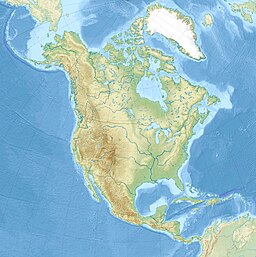| Beaufort Sea | |
|---|---|
 | |
| Coordinates | 72°N 137°W / 72°N 137°W |
| Type | Sea |
| Basin countries | Canada and United States |
| Surface area | 476,000 km2 (184,000 sq mi) |
| Average depth | 124 m (407 ft) |
| Max. depth | 4,683 m (15,364 ft) |
| Water volume | 22,000 km3 (1.8×1010 acre⋅ft) |
| Frozen | Almost all year round |
| References | [1][2][3] |
The Beaufort Sea (/ˈboʊfərt/ BOH-fərt; French: Mer de Beaufort) is a marginal sea of the Arctic Ocean,[4] located north of the Northwest Territories, Yukon, and Alaska, and west of the Canadian Arctic Archipelago. The sea is named after Sir Francis Beaufort, a hydrographer.[3] The Mackenzie River, the longest in Canada, empties into the Canadian part of the Beaufort Sea west of Tuktoyaktuk, which is one of the few permanent settlements on the sea's shores.
The sea, characterized by severe climate, is frozen over most of the year. Historically, only a narrow pass up to 100 km (62 mi) opened in August–September near its shores, but recently due to climate change in the Arctic the ice-free area in late summer has greatly enlarged. Until recently, the Beaufort Sea was known as an important reservoir for the replenishment of Arctic sea ice.[5] Sea ice would often rotate for several years in the Beaufort Gyre, the dominant ocean current of the Beaufort Sea, growing into sturdy and thick multi-year ice.[6][7]
Claims that the seacoast was populated about 30,000 years ago have been largely discredited (see below); present population density is very low. The sea contains significant resources of petroleum and natural gas under its shelf, such as the Amauligak field. They were discovered in the period between the 1950s and 1980s, and since the latter part of that period their exploration has become the major human activity in the area. The traditional occupations of fishing and whale and seal hunting are practiced only locally, and have no commercial significance. As a result, the sea hosts one of the largest colonies of beluga whales, and there is no sign of overfishing as of now. To prevent overfishing in its waters, the US adopted a precautionary commercial fisheries management plan in August 2009.[8] In April 2011, the Canadian government signed a memorandum of understanding with the Inuvialuit as a first step in developing a larger ocean management plan.[9] The Canadian government announced in October 2014 that no new commercial fisheries in the Beaufort Sea will be considered until research has shown sustainable stocks that would be made available to Inuvialuit first.[10]
The Canadian government designated blocks of the Beaufort Sea as Marine Protected Areas (MPAs). The Anguniaqvia niqiqyuam MPA surrounds the Parry Peninsula in the Amundsen Gulf, and the Tarium Niryutait MPA is located at the Mackenzie River delta and estuary.[11][12][13] The protected areas are set to protect species and habitats for the Inuvialuit community.


- ^ R. Stein, Arctic Ocean Sediments: Processes, Proxies, and Paleoenvironment, p. 37
- ^ Beaufort Sea, Great Soviet Encyclopedia (in Russian)
- ^ a b Beaufort Sea, Encyclopædia Britannica on-line
- ^ John Wright (30 November 2001). The New York Times Almanac 2002. Psychology Press. p. 459. ISBN 978-1-57958-348-4. Retrieved 29 November 2010.
- ^ Wood, Kevin R.; Overland, James E.; Salo, Sigrid A.; Bond, Nicholas A.; Williams, William J.; Dong, Xiquan (17 October 2013). "Is there a new normal climate in the Beaufort Sea?". Polar Research. 32: 19552. doi:10.3402/polar.v32i0.19552. ISSN 1751-8369.
- ^ "Disappearing Arctic sea ice". svs.gsfc.nasa.gov. Retrieved 8 September 2020.
- ^ "2019 Arctic Report Card: Old, thick ice barely survives in today's Arctic | NOAA Climate.gov". www.climate.gov. Retrieved 8 September 2020.
- ^ Arctic Fishery Management Plan.
- ^ "Beaufort Sea Commercial Fishing Banned" (CBC News, 15 April 2011).
- ^ "No new fisheries in the Arctic following federal ban"
- ^ "Canada Designates Its Second and Largest Arctic Marine Protected Area". HuffPost.
- ^ "Tarium Niryutait Marine Protected Area (TN MPA)". Government of Canada. 18 September 2019. Retrieved 17 January 2022.
- ^ "Anguniaqvia niqiqyuam Marine Protected Area (MPA)". Government of Canada. 18 September 2019. Retrieved 17 January 2022.
